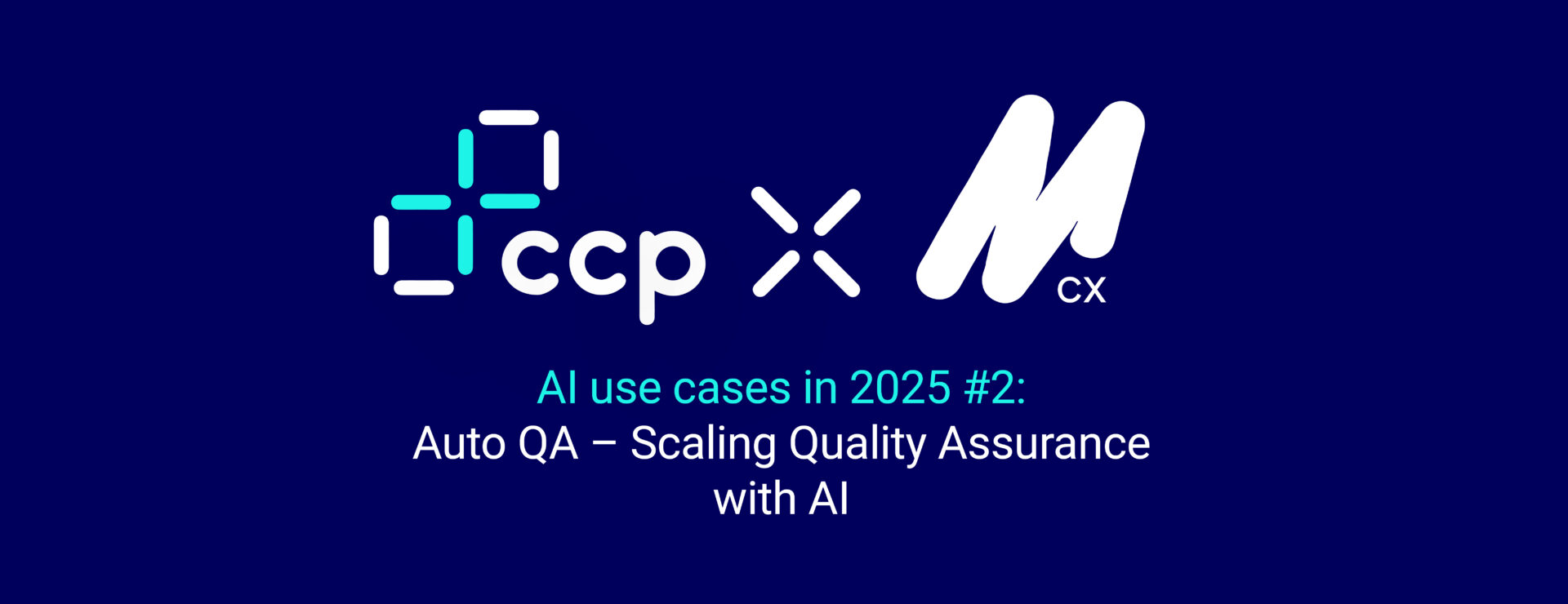
Quality assurance (QA) is a staple of every contact centre, more so where compliance and regulation demand it. Traditionally, manual QA reviews are concerned with the customer interaction itself, are labour-intensive and typically cover only 1-2% of calls.
While manual QA will pick up some training points, through a lack of comprehensive coverage, it often misses systemic issues that haven’t become immediately obvious elsewhere in the organisation but that could be found buried in call analysis.
What is the AI doing in Auto QA?
Auto QA uses artificial intelligence to automate the evaluation of both customer interactions through transcription (remember use case 1 – autowrap) and sentiment analysis, and what the agent did on systems.
Let’s examine the benefits.
Key benefits: Comprehensive coverage
With AI, it is possible to cover 100% of interactions; to fully assess agent performance consistently and at scale across all interactions and all areas of the QA scorecard, and send alerts straight to a team leader’s desktop.
Resource optimisation
With manual QA, you typically see around a 1:30 or 1:50 ratio of manual QA people to agents. But with Auto QA, you can expect around a 75% reduction in that overhead. Which is significant when working on fine margins, either in headcount reduction, or redirecting those resources to transformation or speech analysis tasks as opposed to data gathering.
Consistent evaluations
As with any human task, while we may believe all QA people are using their scorecard and delivering in the same way, even with calibration sessions and financial incentives, the chances of that being the case are slim; you may already know this from those calibration sessions. Indeed, the interpretation of the calibration itself may be flawed – for example, two different people may have very different takes on what constitutes empathy.
So while an AI scorecard evaluation of a voice interaction may, for example, only be 80% accurate to begin with, it is consistently 80% accurate, as opposed to the potential for human analysis to vary significantly and most likely sit at a lower accuracy figure of around 65%. Meaning more calls are scored at greater accuracy overall.
Real-time feedback
Finally, the benefits of real-time feedback while softer, are easy to understand. And completely measurable via the scorecard.
First, immediately picking up training points allows the agent to implement improvements on the very next interaction.
And second, for an agent taking hundreds of calls a day, picking up a training point even a few hours after the call occurred – especially if the interaction reason or resolution is atypical – makes it harder for the improvement points to stick, even with the benefit of the call to hand.
Implementation considerations
Aside from systems integrations, data privacy and compliance – and instead focusing more on the vagaries, of AI – accuracy (or lack of it) immediately translates through to an impact on human resources, where a less accurate AI could result in wasting resources on issues that aren’t issues.
Which is why it is always desirable to ensure there are humans in the loop (HITL), both in training, developing and refining the AI models, or in the process of checking its conclusions before delivering feedback.
With a combination of human review and machine learning improvements, the 80% accuracy figure can be improved to 85-90% accuracy in around four weeks, at which point you can consider pointing the human resources to different tasks. For systems interactions, including chat, you would expect greater accuracy from the AI from the outset, as it immediately has controlled data to assess.
If you can achieve 95-100% accuracy, per Mojo CX’s claims, then you can be confident human resources are targeted to where they are needed most. It may even be that you are willing to accept a lower rate of accuracy if the QA benefits outweigh the wastage. This is a decision unique to your business. And so as with use case 1, it’s important to understand the true baseline that the AI is improving upon.
Elsewhere, you may choose not to assess 100% of calls for processing and ESG reasons. These are all tolerances and optimisations that you can test and set to deliver against competing KPIs.
Measuring Auto QA success
For any AI implementation, it’s important to measure its success as this will build the case for future implementations. Whether that’s headcount, resource allocation QA KPIs or any of the many other contact centre KPIs.
In summary, the benefits are:
· 75% reduction in QA processing time
· 50-100 x increase in evaluated interactions
· 15-25% increase in evaluation accuracy and consistency
· Greater and faster improvement in agent performance and CSAT
While undoubtedly a little more complex to implement than use case 1, implementing Auto QA builds on those foundations by making use of call transcription and taking it to the next level.
To find out more about how CCP can help you make the right technology choices, read more here or get in touch.
This series of articles is drawn from our webinar with Jimmy Hosang, CEO and co-founder at Mojo CX. We explored seven key use cases for AI in contact centres, starting from the easiest productivity gains to value generating applications. You can find a summary of all seven use cases here, or watch the webinar in full here.




